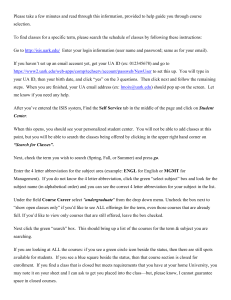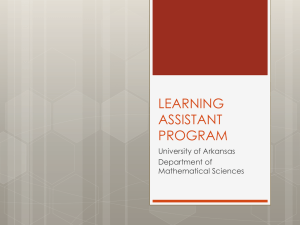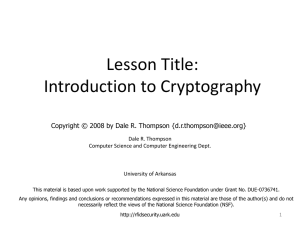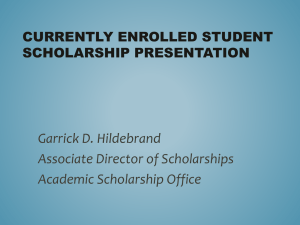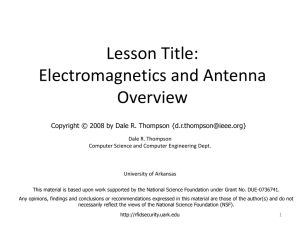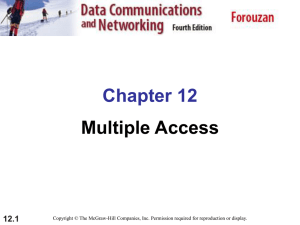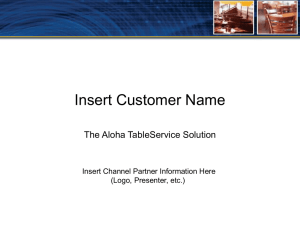RFID and Threat modelling
advertisement
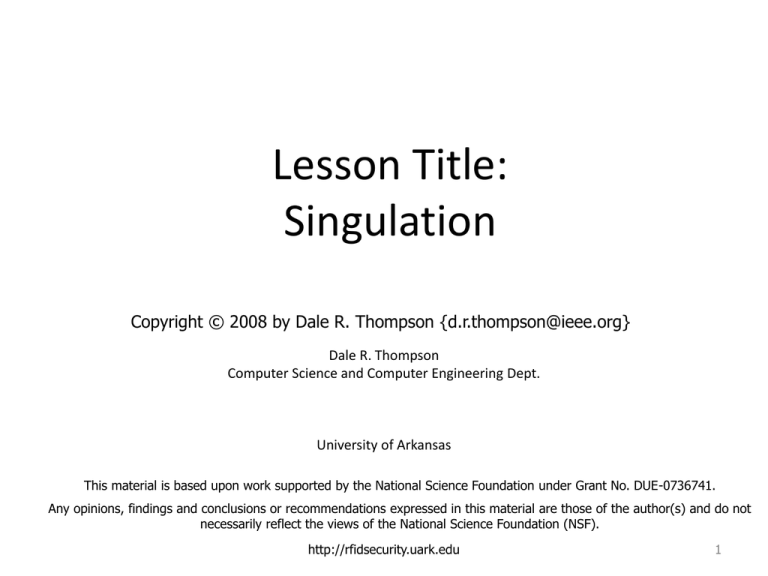
Lesson Title:
Singulation
Copyright © 2008 by Dale R. Thompson {d.r.thompson@ieee.org}
Dale R. Thompson
Computer Science and Computer Engineering Dept.
University of Arkansas
This material is based upon work supported by the National Science Foundation under Grant No. DUE-0736741.
Any opinions, findings and conclusions or recommendations expressed in this material are those of the author(s) and do not
necessarily reflect the views of the National Science Foundation (NSF).
http://rfidsecurity.uark.edu
1
Singulation
• Singulation is the process that a reader
performs to identify and/or communicate with
a particular tag in the presence of multiple
tags that are in range of the reader.
http://rfidsecurity.uark.edu
2
Anti-collision Algorithm/Protocol
• An anti-collision protocol is the protocol used
to prevent two or more devices from
interfering with each other in a common
communication channel to share the medium.
They are also called medium access control
(MAC) protocols.
http://rfidsecurity.uark.edu
3
Time division multiplexing (TDM)
http://rfidsecurity.uark.edu
4
Frequency division multiplexing (FDM)
http://rfidsecurity.uark.edu
5
Polling
http://rfidsecurity.uark.edu
6
Random access
http://rfidsecurity.uark.edu
7
Pure Aloha
http://rfidsecurity.uark.edu
8
Pure Aloha Efficiency
http://rfidsecurity.uark.edu
9
Slotted Aloha
http://rfidsecurity.uark.edu
10
Slotted Aloha Efficiency
http://rfidsecurity.uark.edu
11
Pure Aloha vs Slotted Aloha
http://rfidsecurity.uark.edu
12
Questions
• What is the difference between pure and
slotted Aloha?
• Which is more efficient, pure or slotted Aloha?
http://rfidsecurity.uark.edu
13
Framed slotted Aloha
http://rfidsecurity.uark.edu
14
Framed slotted Aloha Efficiency
http://rfidsecurity.uark.edu
15
Questions
• What is the difference between slotted Aloha
and framed slotted Aloha?
http://rfidsecurity.uark.edu
16
Gen-2 Anti-Collision Protocol (media access
control)
•
Select phase
– Single out particular tag population with one or more bits with query tree protocol
•
Inventory phase – identify individual tag using Q protocol (slotted-aloha based)
–
–
–
–
–
–
–
–
•
Reader sends Query with parameter Q and Session number (Q=4 is suggested default)
Reader creates slotted time
Tags pick random 16-bit number for handle
Tags in requested session pick a random number in the range [0,2^Q-1] for slot_number
If slot_number = 0, backscatter handle
If slot_number != 0, wait that number of slots to backscatter handle
Reader ACKs individual tag with handle and goes to access phase. All other tags wait.
If more that one tag answers, reader can send same Q again or send modified Q
Access phase
– Reader interacts with tags requesting EPC number and any other information
http://rfidsecurity.uark.edu
17
Gen-2 Select (Query Tree)
Time slice
Reader-to-Tag
0
1
0**
2
3
00*
4
5
01*
Tag-to-Reader
collision
no answer
collision
Tag1 (ID = 010)
010
010
Tag2 (ID = 011)
011
011
Tag3 (ID = 100)
Time slice
Reader-to-Tag
6
7
010
8
9
011
Tag-to-Reader
010
Tag1 (ID = 010)
010
Tag2 (ID = 011)
10
11
1**
011
100
011
Tag3 (ID = 100)
100
http://rfidsecurity.uark.edu
18
Gen-2 Select (Query Tree)
http://rfidsecurity.uark.edu
19
Gen-2 Inventory
(Q protocol, form of slotted Aloha)
Time slice
0
1
Slot number
Reader-to-Tag
2
3
4
5
0
1
2
3
Query Q=2
handle1
collision
slot=0
Tag2
slot=1
handle2
Tag3
slot=1
handle3
9
Slot number
Reader-to-Tag
empty
empty
EPC1
EPC1
Tag1
8
7
ACK handle1
Tag-to-Reader
Time slice
6
handle1
10
11
12
13
0
1
2
3
14
15
ACK handle2
QueryAdjust
Tag-to-Reader
empty
Tag1 (ID = 010)
wait
Tag2 (ID = 011)
slot=1
Tag3 (ID = 100)
slot=3
handle2
empty
handle3
EPC2
EPC2
handle2
handle3
http://rfidsecurity.uark.edu
20
Q-protocol efficiency
http://rfidsecurity.uark.edu
21
Question
• What is the relationship between Q and the
number of users?
http://rfidsecurity.uark.edu
22
Contact Information
Dale R. Thompson, Ph.D., P.E.
Associate Professor
Computer Science and Computer Engineering Dept.
JBHT – CSCE 504
1 University of Arkansas
Fayetteville, Arkansas 72701-1201
Phone: +1 (479) 575-5090
FAX: +1 (479) 575-5339
E-mail: d.r.thompson@ieee.org
WWW: http://comp.uark.edu/~drt/
http://rfidsecurity.uark.edu
23
Copyright Notice, Acknowledgment, and Liability
Release
•
•
•
Copyright Notice
– This material is Copyright © 2008 by Dale R. Thompson. It may be freely redistributed in its entirety
provided that this copyright notice is not removed. It may not be sold for profit or incorporated in
commercial documents without the written permission of the copyright holder.
Acknowledgment
– These materials were developed through a grant from the National Science Foundation at the
University of Arkansas. Any opinions, findings, and recommendations or conclusions expressed in
these materials are those of the author(s) and do not necessarily reflect those of the National
Science Foundation or the University of Arkansas.
Liability Release
– The curriculum activities and lessons have been designed to be safe and engaging learning
experiences and have been field-tested with university students. However, due to the numerous
variables that exist, the author(s) does not assume any liability for the use of this product. These
curriculum activities and lessons are provided as is without any express or implied warranty. The
user is responsible and liable for following all stated and generally accepted safety guidelines and
practices.
http://rfidsecurity.uark.edu
24

